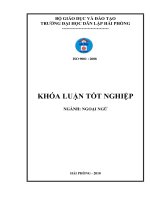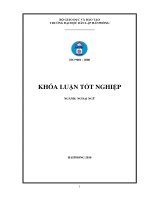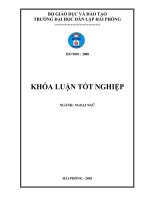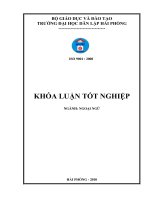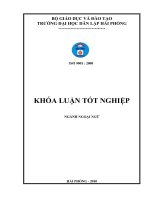A study on translation of expressions used in some Vietnamese dishes into English
Bạn đang xem bản rút gọn của tài liệu. Xem và tải ngay bản đầy đủ của tài liệu tại đây (468.42 KB, 63 trang )
Bộ GIáO DụC Và ĐàO TạO
TRƯờNG ĐạI HọC DÂN LậP HảI PHòNG
-------------------------------
ISO 9001 : 2008
KHóA LUậN TốT NGHIệP
NGàNH: ngoại ngữ
HảI PHòNG - 2010
HAIPHONG PRIVATE UNIVESITY
FOREIGN LANGUAGES DEPARTMENT
-----------------------------------
GRADUATION PAFER
HOW TO IMPROVE LISTENING SKILLS IN TOEIC
THE CASE OF:
- Questions and responses
- Short conversations
By:
Nguyễn Thị Trang
Class:
NA1003
Supervisor:
Mai Văn Sao, M.A
HAI PHONG - 2010
Bộ GIáO DụC Và ĐàO TạO
TRƯờNG ĐạI HọC DÂN LậP HảI PHòNG
nhiệm vụ đề tài tốt nghiệp
Sinh viờn: ..................................................................Mó s: ..................................
Lp:.......................... Ngnh: ..................................................................................
Tờn ti: ................................................................................................................
...............................................................................................................
...............................................................................................................
...............................................................................................................
NHIỆM VỤ ĐỀ TÀI
1. Nội dung và các yêu cầu cần giải quyết trong nhiệm vụ đề tài tốt nghiệp
(Về lý luận, thực tiễn, các số liệu cần tính toán và các bản vẽ)
.................................................................................................................................
.................................................................................................................................
.................................................................................................................................
.................................................................................................................................
.................................................................................................................................
.................................................................................................................................
.................................................................................................................................
.................................................................................................................................
.................................................................................................................................
2. Các số liệu cần thiết để thiết kế, tính toán.
.................................................................................................................................
.................................................................................................................................
.................................................................................................................................
.................................................................................................................................
.................................................................................................................................
.................................................................................................................................
.................................................................................................................................
.................................................................................................................................
.................................................................................................................................
3. Địa điểm thực tập
.................................................................................................................................
.................................................................................................................................
.................................................................................................................................
.................................................................................................................................
.................................................................................................................................
.................................................................................................................................
CÁN BỘ HƯỚNG DẪN ĐỀ TÀI TỐT NGHIỆP
Người hướng dẫn thứ nhất:
Họ và tên: ................................................................................................................
Học hàm, học vị: .....................................................................................................
Cơ quan công tác: ....................................................................................................
Nội dung hướng dẫn: ...............................................................................................
.................................................................................................................................
Người hướng dẫn thứ hai:
Họ và tên: ................................................................................................................
Học hàm, học vị: .....................................................................................................
Cơ quan công tác: ....................................................................................................
Nội dung hướng dẫn: ...............................................................................................
.................................................................................................................................
Đề tài tốt nghiệp được giao ngày 12 tháng 04 năm 2010
Yêu cầu hoàn thành trước ngày 10 tháng 07 năm 2010
Đã nhận nhiệm vụ ĐTTN
Đã giao nhiệm vụ ĐTTN
Người hướng dẫn
Sinh viên
Hải Phòng, ngày tháng
năm 2010
HIỆU TRƯỞNG
GS.TS.NGƯT Trần Hữu Nghị
PHIẾU NHẬN XÉT TÓM TẮT CỦA CÁN BỘ HƯỚNG DẪN
1. Tinh thần thái độ của sinh viên trong quá trình làm đề tài tốt nghiệp
.................................................................................................................................
.................................................................................................................................
.................................................................................................................................
.................................................................................................................................
.................................................................................................................................
.................................................................................................................................
.................................................................................................................................
2. Đánh giá chất lượng Đ.T.T.N ( so với nội dung yêu cầu đã đề ra trong
nhiệm vụ Đ.T.T.N trên các mặt lý luận, thực tiễn, tính toán giá trị sử
dụng, chất lượng các bản vẽ)
.................................................................................................................................
.................................................................................................................................
.................................................................................................................................
.................................................................................................................................
.................................................................................................................................
.................................................................................................................................
.................................................................................................................................
3. Cho điểm của cán bộ hướng dẫn (Ghi bằng cả số và chữ)
.................................................................................................................................
.................................................................................................................................
.................................................................................................................................
Hải Phòng, ngày........tháng........năm 2010
Cán bộ hướng dẫn
(Họ tên và chữ ký)
NHẬN XÉT VÀ ĐÁNH GIÁ CỦA CÁN BỘ CHẤM PHẢN
BIỆN ĐỀ TÀI TỐT NGHIỆP
1. Đánh giá chất lượng đề tài tốt nghiệp về các mặt thu nhập và phân tích số
ban đầu, cơ sở lý luận chọn phương án tối ưu, cách tính toán chất lượng
thuyết minh và bản vẽ, giá trị lý luận và thực tiễn đề tài.
2.
Cho điểm của cán bộ phản biện
(Điểm ghi bằng số và chữ)
Ngày..............tháng................năm 2010
Người chấm phản biện
ACKNOWLEDGEMENTS
In the process of doing my research paper, I have received a lot of
help, encouragement and experience from teachers and friends. Especially,
my graduation subject now is completed successfully thanks to all teachers’
support at Hai Phong Private University (HPU).
First of all, I would like to express my sincere thank to my supervisor
Mr. Mai Van Sao, MA who has generously given me invaluable assistance
and guidance. Without his help, this paper will not be successfully done.
Besides, my sincere thank is also extended to all the students who
help me fulfill the survey questions. Finally, I am grateful to my family and
friends who have given me much encouragement during the time I carried
out this paper.
Hai Phong, June 2010
Student
Nguyen Thi Trang
TABLE OF CONTENTS
PART I: INTRODUCTION
1. Rationale...................................................................................... 01
2. Aim of the study .......................................................................... 02
3. Scope of the study ....................................................................... 02
4. Method of the study .................................................................... 03
5. Design of the study ..................................................................... 03
PART II: DEVELOPMENT
CHAPTER ONE: THEORETICAL BACKGROUND
I. TOEIC test .................................................................................... 05
1. What is TOEIC test? ................................................................... 05
1.1. General definition about TOEIC test .................................... 05
1.2. Typical TOEIC test ............................................................... 06
1.3. TOEIC format ....................................................................... 06
II. Listening comprehension in TOEIC test
1. Part one: Pictures description ..................................................... 07
2. Part two: Questions and responses .............................................. 08
3. Part three: Short conversations ................................................... 08
4. Part four: Short talks ................................................................... 08
CHAPTER TWO: THE STUDY ON TOEIC LEVEL 2
STUDENTS’ DIFFICULTIES AT HAI PHONG PRIVATE
UNIVERSITY AND SUGGESTED SOLUTIONS
I. Reality
1. Context ........................................................................................ 09
1.1 Objective situation ................................................................ 09
1.2 Subjective situation .............................................................. 09
2. The design and focus of the English the book ―Reward‖ ............ 09
II. Survey questionnaires
1. Method of survey ........................................................................ 10
2. Objectives of the survey .............................................................. 10
3. Data analysis ............................................................................... 11
3.1. Students’ opinion of listening ............................................... 11
3.2. The surveyed students’ general opinion toward TOEIC test. 12
3.3. Most of the students are not good English speakers .............. 14
3.4. The problems you have faces when listening in TOEIC test 14
3.5. It’s nessessary to have a research paper about improving
listening skill in TOEIC test, the case of: questions-responses
and short conversations ......................................................... 16
CHAPTER III: HOW TO IMPROVE LISTENING SKILLS IN
TOEIC TEST THE CASE OF:
- Questions and Responses
- Short conversations
I. REASONING ................................................................................. 18
II. FINDING..................................................................................... 18
III. SUGGESTED GLOSSARY CONFERENCE ........................... 19
1. Using telephone ........................................................................... 19
2. Greeting people and responding ................................................. 21
3. Making and responding to instruct ............................................. 25
4. Saying GOODBYE ...................................................................... 26
5. Asking for information ................................................................ 28
6. Giving direction and instructions ................................................. 29
7. Thanking people and responding to thanks ................................. 30
8. Making, accepting and declining invitation................................. 32
9. Making and responding request ................................................... 33
10. Apologizing and responding ...................................................... 34
11. Making excuses .......................................................................... 35
12. Complimenting and responding ................................................. 36
13. Complaining ............................................................................... 37
14. Express opinions, Agreeing or Disagreeing .............................. 38
15. Requesting and offering assistance ............................................ 39
16. Attracting attention and Warning .............................................. 40
17. Expressing and receiving sympathy .......................................... 42
18. Hiding feelings ........................................................................... 44
IV. Application ................................................................................ 44
PART III: CONCLUSION ........................................................... 46
APPENDIX
SURVEY QUESTIONNAIRE ...................................................... 48
PART I: INTRODUCTION
1. Rationale
English is a global language used by millions of people all over the
world. Obviously, English connects people, shorten the distance and makes
everybody closer and closer.
In modern society, it is considered as an indispensable language in the
process of communicating with various kinds of people from different
courtesies. Mastering English is the best way for us to have a great deal of
opportunities to reach the success in life.
Now, TOEIC is an English examination that tests your knowledge of
business English in four key areas: reading, listening, grammar and
vocabulary. TOEIC is a very challenging examination, and unfortunately,
many students find it hard to achieve the score they need. One reason for this
is that the TOEIC questions use many challenging words, so students need a
good vocabulary. The other reason is listening skills in TOEIC test, this is a
major factor make students rarely give high score. Listening comprehension
in TOEIC test come lot of difficulties for the student, specially, the case of:
Questions-Responses and Short conversations.
There are 2 basic reasons make the students poor listening: they are
objective situation and subjective situation.
Objective situation
• Poorly equipped TOEIC and listening materials
• Unqualified listening facilities
Subjective situation
HPU students’ limited listening competence
Insufficiency of vocabulary and grammar
Passive attitude in listening
Low speculation ability of situations
1
From the above reasons, I would like to choose the research paper
entitled: ―How to improve listening skills for non-English major students in
TOEIC test level 2, the case of: Questions-responses and short
conversations.‖
In my opinion, the most important reason is low speculation ability of
situations so that with my English knowledge limitation and the frame of
graduation paper, I make a sketchy presentation on some specific situations in
English to improve speculation ability of situations. This will help the
students to hold initiative in listening. I hope that, with my research paper,
you will enhance ability of listening to reach high score in TOEIC test.
2. Aim of the study
The main goal of my research paper is to provide students suggested
glossary conference to improve listening skills, particularly for the parts:
Questions-Responses and short conversations in TOEC test level 2 for nonEnglish major students. In order to gain that aim, the specific objects of the
study are:
To study the theory of Listening comprehension, focusing on listening
part 2 and 3 in TOEIC test, structure of each part and some tips to do it.
To get know about the reality of listening in TOEIC test to nonEnglish major students at HPU with specific facts and figures.
To provide functional English with specific communicative situations
to enhance communicative skills as well as listening skills in TOEIC test.
3. Scope of the study
In fact, there are lots of various methods to improve listening skills in
TOEIC test, the case of part 2 and 3. It requires much of time and effort.
However, due to the limitation of time, resources and knowledge of mine, this
study can only focus on study the best way which suitable for the student is
social communicative situations with giving questions and responses to serve
effectively for answer the listening comprehension, the case of part 2 and 3 in
TOEIC test level 2.
2
4. Methods of the study
To complete this graduation paper, a series of methods have been
applied:
Collected references, books and websites related to TOEIC test and
documents were analyzed in details to form the theoretical background this
paper.
A survey questionnaire is conducted for non-English major students
at Hai Phong Private University, the information from which has invaluable.
Suggestions experience from my supervisor Mr. Mai Van Sao, M.A.
and my understanding at Hai Phong Private University and gained experience
in training course.
5. Design of the study
The study is divided into three mains:
Part one is INTRODUCTION that indicates the rationale for choose this
topic, pointing out the aim, the scope as well as the methods of the study.
Part two named THE STUDY, which consists of three chapters:
- Chapter
1:
―theoretical
background”
focuses
on
listening
comprehension in TOEIC test particularly, part 2: questions-responses and
part 3: short conversations. Besides, it focuses on my knowledge about social
English to serve effectively for giving suggestions.
- Chapter 2: “the study on TOEIC level 2 students’ difficulties at Hai
Phong Private University and suggested solutions” refers to the survey
questionnaire and analyzed findings of questionnaire’s results.
- Chapter 3: ―How to improve non-English major students’ listening
skills for TOEIC test level 2 at Hai Phong Private University, the case of:
Question-Responses and short conversations” that contain 18 social
communicative structures with specific situations to provide the students with
of common daily expressions through. Base on that, the students can predict
the questions and answer in listening comprehension part 2 and part 3.
3
Part three is CONCLUSION in which all the issued mentioned above
are summarized.
Briefly, part 1 has referred to rationale, aims, scopes, method and designs
of the research paper. In the part 2, the study will focus on the study the study
on TOEIC level 2 students’ difficulties at Hai Phong Private University and
suggested solutions.
4
PART II: DEVELOPMENT
CHAPTER ONE: THEORETICAL BACKGROUND
I. TOEIC test
1.What is TOEIC test?
1.1 General definition about TOEIC test
TOEIC - Test of English for International Communication which the
Educational Testing Service (ETS) is one of the most common English
language tests in the world today. The aim of the TOEIC is to measure the
ability to speak, read and understand basic business English. For this reason,
the TOEIC has become the preferred exam for corporations, governmental
agencies and many educational institutions to test learners' English
capabilities. This exam evaluates your ability to function in international
business and real-world settings rather than in an academic setting.
Some students take the TOEIC because they want to improve their
English. Other students take the TOEIC because they need it for an intensive
English course or they want to apply for a job that requires a TOEIC score.
Every institution expects a different standard of proficiency from its
employees or students
TOEIC consists of two sections: listening comprehension and reading.
There are 100 questions in each section. Separate scaled scores are provided
for each section, the part score scales ranging from five to 495 and the total
score scales ranging from 10 to 990.
The TOEIC test provides a good
indication of candidates' language abilities in English. The mean scores of all
the direct measures showed a consistent relationship with the appropriate
TOEIC part scores.
5
1.2 Typical TOEIC topics
Here are some of the topics on the TOEIC:
Typical TOEIC Topics
Banking
Jobs
Entertainment
Offices
Health
Restaurants
Housing
Transportation
Industry
Travel
1.3 TOEIC Format
TOEIC Format
Listening and Reading Test
Listening
100 questions, 45 minutes
Part I: Photographs (10 questions)
Part II: Question-Response (30 questions)
Part III: Short Conversations (30 questions)
Part IV: Short Talks (30 questions)
Reading
100 questions, 75 minutes
Part V: Incomplete Sentences (40 questions)
Part VI: Text completion (12 questions)
Part VII: Reading Comprehension-Single Passages (28 questions) Double
Passages (20 questions)
6
II. Listening comprehension in TOEIC test
45 minutes
Testing time:
Number of
100
questions:
The exam will include an audio CD and a
Test
administration:
booklet. Your answers will be recorded with
paper and pencil.
Scored by ETS trained raters.
Scoring:
Part
Topic
Questions
1
Photographs
10
2
Question-Response
30
3
Short Conversations
30
4
Short Talks
30
Many test-takers believe that the Listening portion of the TOEIC is the
most difficult part of the test, even though it only runs approximately 45
minutes. Why? Both the questions and possible responses for Parts One and
Two are only heard, not printed. In Parts Three and Four, the questions will
be either printed or spoken, so it’s a little easier.
* Skills test:
- Vocabulary in context
- Idioms in context
- Grammar
1.Part one: Pictures description (10 questions)
In this part you will see a photograph and you will hear four sentences
describing the photo. You must choose the sentence that most closely
7
matches what you see. You will hear the sentences once.
You will identify what you see in the photo. This may include people,
objects, actions, and locations both general and specific. You will also make
assumptions, you may not be able to determine if something is actually taking
place, but from the clues in the photo, you can assume that it is.
2. Part two: Questions and Responses (30 questions)
In this part, you will hear a question and three possible responses. You
must choose the response that best answer the question. You will hear the
question and each response once.
The question may ask about people, location, time, an activity, an event,
emotions, reasons or opinions. In short, the question could be on almost
subject.
3. Part Three: Short conversations (30 questions)
In this part, you will hear a short dialogue. You will read a question and
four answer choices in your test booklet. You must choose the opinion that
the best the answers question. You will only hear the dialog once.
The question will ask about the general idea of the conversation; usually
it will not focus on specific details. You will be asked to identify an activity,
an emotion, a relationship, or the location of the speakers. In some instances
you may have to do some minor calculations based on measurements in the
dialogs.
4. Part Four: Short talks (30 questions)
In this part, you will hear a short monologue about which you will read two
or three questions in your test booklet. For each question, you must choose the
correct answer from four opinions. You will hear the monologue once.
The talks can be in the form of recorded announcements, weather
forecasts, special bulletins, etc. The questions will ask you to determine the
location, the speaker, the time, the event, or a reason.
8
CHAPTER TWO
THE STUDY ON TOEIC LEVEL 2 STUDENTS’
DIFFICULTIES AT HAIPHONG PRIVATE UNIVERSITY
AND SUGGESTED SOLUTIONS
I. Reality
1. Context
1.1. Objective situation
- Poorly equipped TOEIC and listening materials
- Unqualified listening facilities
1.2 . Subjective situation
- HPU students’ limited listening competence
Insufficiency of vocabulary and grammar
Passive attitude in listening
Low speculation ability of situations
2. The design and focus of the English the book “Reward”
In the school, non-English majors have been working with the newest
pilot material text book. It consists of forty units which are theme-bases and
eight consolidation units. Each unit has following parts:
Reading and vocabulary: presents a 350-400 word text that helps
students get acquainted with the theme of the unit, provide grammar,
vocabulary… And developing reading skill.
Listening: it gives maybe a text or dialogue related the theme of the
unit. Its aim is to practice listening skill. Additional, this part also helps
correct pronunciation, consolidate grammatical structure.
Speaking: This part consists of activities for practicing speaking skills
such as: pair work, group work, individual… Of course, students will
communicate up to linguistic function and the theme of each unit.
Writing: this part has many exercises that can support students’ writing
skill up to different types of paragraphs such as: letter, narration, data
9
description, etc…
Language focus: is formed from two subparts: pronunciation, grammar
and vocabulary.
Pronunciation: is to review the way of pronouncing vowels and
consonants.
Grammar: refers to grammatical structures that are focused in that unit.
It can be practiced in the form of exercise or communicating.
Eight consolidation units are presented in the test yourself form. These
are designed so that students can check their own knowledge after learning 15 units and help teachers design a 45-minutes test.
II. Survey questionnaires
1. Method of survey
In this survey, I used survey questionnaire to get information. In this
survey questionnaire, set of questionnaire is non-English major students at
Hai Phong private university who have joined in TOEIC test level 2.
There are 10 questions conducted in order to study:
Their general attitude toward TOEIC test
Their general attitude to ward listening comprehension in TOEIC test
How do they do to improve listening skill in general as well as in
TOEIC test?
Their though about ―questions-responses‖ and ―short conversations‖
section in TOEIC test.
The relationship between speaking and listening.
2.
Objectives of the survey
The general goal of this study is to have a right look at role of listening in
communication and TOEIC test in order to find out better methods to improve
listening skill in TOEIC test level 2, the case of: questions-responses and
short conversations.
This survey has following purposes:
10
To do research listening skill in TOEIC test, the case of: Questions-
responses, and short conversations.
To study how to improve listening skill in TOEIC test, the case of:
Questions-responses and short conversations.
3.
Data analysis
The number of students taking part in the survey is eighty six students.
They are all studying at Hai Phong Private University and they have joined in
TOEIC test, include in English non-major and English-major students.
3.1. Students’ opinion of listening
3.1.1.
Role of listening in social communication is very important.
Very important
Important
Not very important
Not important
97%
3%
0%
0%
Question1: (Appendix1) How do you think about listening in social
communication?
This question to find role of listening in social communication and most
students see the importance and the role of listening in social communication.
3.1.2. The relationship between speaking and listening is close
relationship.
Close relationship
Not
close relationship
100%
0%
11
Question 2: How do you think about relationship between listening and
speaking?
The results indicate that speaking and listening are closer relationship.
You will become a good listener when you are a good speaker. Normally, the
spoken English are possibility listen English well. Therefore, we recognize
that we can improve listening when improve speaking skill.
3.2. The surveyed students’ general opinion toward TOEIC test
3.2.1. Students’ opinion that TOEIC test is difficult.
Question 3: (appendix1) How difficult is TOEIC test to you?
This question to research students’ in TOEIC test, 5% give their opinion
that TOEIC test is easy, these student give this response are good candidate.
Most students see this test is difficult.
3.2.2 It’s very difficult to get over 800 points in TOEIC test.
500-595
600-695
700-795
Over 800
Another
points
points
points
points
points
12
52%
21%
14%
7%
6%
Question4: (Appendix1) Have you got over 800 points in TOEIC test?
According to the bar chat, the students get over 800 points in TOEIC test
at HPU is 7%, it’s low percentage and 52% of the students get 500-595
points. Why is very unequal like that? There are many reasons lead to low
point of the students in TOEIC test such as: lack of knowledge of vocabulary,
unqualified listening facilities, and test skill.
3.2.3. Listening comprehension is more difficult than reading comprehension.
Question
5:
Reading
Listening
19%
81%
(Appendix)
As
for
comprehension, what is more difficult?
13
you
reading
and
listening
This question to find out one of the reasons lead to difficult to get high point
in TOEIC test for non-English major students’ at HPU. With 81% showed that
listening comprehension is more difficult than reading in TOEIC test.
3.3. Most of the students are not good English speakers
Yes
No
25%
75%
Question 6: (Appendix1) are you a good English speaker?
As you know, listening and speaking are close relationship, 81% students
said that listening comprehension is more difficult than reading section, while
75% showed that they aren’t good speaker?
Listening and speaking are important skills to English learner, especially;
listening in TOEIC test is very important because TOEIC test is a
standardized test that measures your listening and reading skills.
3.4. The problems you have faced when listening in TOEIC test.
3.4.3.Speed of the speaker is very fast
Fast
So fast
Slow
Another ideas
76%
19%
1%
4%
14

